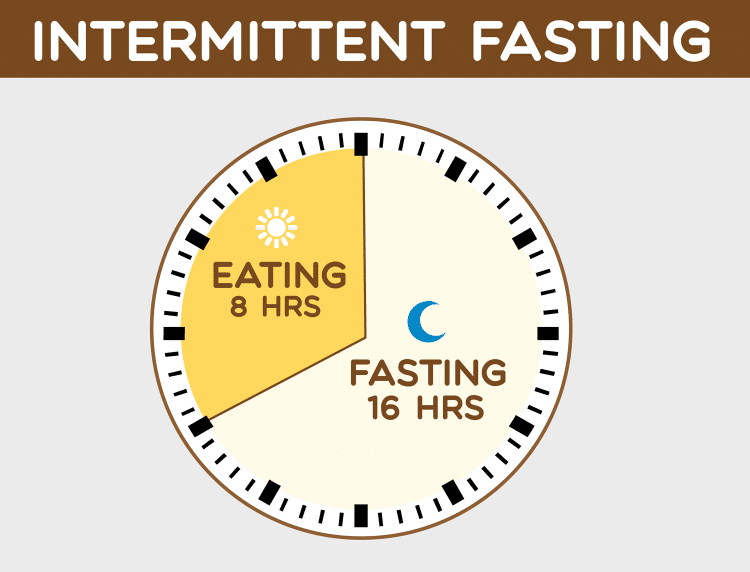Intermittent fasting is arguably the fastest-growing fitness trend of all time. It is echoing through gyms and online forums, and you’ve probably seen celebrities and athletes swear by it.
Intermittent fasting (IF) involves cycling between periods of eating and voluntary fasting. There are several IF methods that you can choose from but the 16:8 protocol is by far the most popular.
Scientific evidence shows that 16:8 intermittent fasting can help with weight loss, improve metabolic health, and reduce the risk of diabetes and cardiovascular disease. (1)
Sounds impressive, right?
I decided to give intermittent fasting a shot as I wanted to shed a few stubborn pounds, boost my energy levels, and most importantly, assess if IF is really as effective as people claim.
In this article, I take you over how following an intermittent fasting program for 30 days impacted my weight, energy levels, satiety, and workout performance. I’ll also share actionable tips that will help you adapt this diet to your unique needs.
Level Up Your Fitness: Join our 💪 strong community in Fitness Volt Newsletter. Get daily inspiration, expert-backed workouts, nutrition tips, the latest in strength sports, and the support you need to reach your goals. Subscribe for free!
Why I Chose the 16:8 Protocol & How To Set Realistic Expectations
Initially, I was torn between the 16:8 and the 5:2 protocol. What made me pick the former, you ask?
I am a big believer in making sustainable lifestyle changes so that you can stick to them for the long term. If something adds friction to your daily routine, it’s only a matter of time before you will give up on it.
While the 5:2 intermittent fasting routine can be effective, it requires you to change your routine two days a week. This might not be a big deal for some people, but I tend to forget when I have to follow certain protocols on specific days of the week.
For instance, I can never remember to take my vitamin D tablets on Monday and end up consuming them on Tuesdays and Wednesdays. (I’m writing this on a Tuesday, which reminds me that I’ve not taken my vitamins yet.)
You could have a reminder on your phone for this, but who wants to deal with another alert? This ends up feeling buggy and frustrating.
On the other hand, the 16:8 protocol involves sticking to the same daily routine. You must limit your food and calorie-containing beverage intake to a set window of eight hours each day. The 16:8 intermittent fasting method can integrate into your lifestyle perfectly.
Most people, me included, schedule our days so that a bulk of the 16 hours align with our sleeping schedule. I eat my breakfast at noon and have my last meal before 8 p.m. You can adopt this same schedule or find something that works better for you.
Week-by-Week Breakdown of the 30-Day 16:8 IF Challenge
I had heard about the benefits of the 16:8 intermittent fasting program for a very long time, so I decided to put it to the test. Here’s my week-by-week breakdown of this 30-day challenge.
Week One: The Initial Shock
While I knew I would need some time to get used to intermittent fasting, I had no idea that changing my eating habits would take such a big toll on my body and mind.
I train at 8 a.m. after eating a big breakfast. Now that I was following a 16:8 IF protocol, I had to skip my meal, and this was arguably the biggest adjustment I had to make to my daily routine. Working out without any food in me definitely hampered my performance, as I could not push myself hard enough.
It did not end there. The hunger pants were for real, and my stomach rumbled like a construction site at around 11 a.m., and I could not just wait to eat.
I also experienced a decline in my concentration power and felt sluggish, especially after finishing my workout. Until now, I had thought ‘hangry’ was just a funny word, but this diet program made me realize this is the real deal. Initially, my patience wore thin, and I snapped at minor things — my wife can attest to this.
Besides irritability, I also experienced mild headaches throughout the first week of this challenge, which was likely caused by the sudden change in my blood sugar levels.
Water, black tea, and unsweetened tea were my saviors during these first seven days as I constantly questioned the decision to try this diet. Remember, you can consume anything during the fasting window as long as it has zero calories.
Coach Tip: If possible, schedule your workout during your eating windows. This will ensure you have enough energy to get the best bang for your training buck.
Week Two: Finding a Rhythm
Thankfully, the second week wasn’t as brutal as the first as my body had started to adapt to this new routine.
I made specific changes in my eating window around the final days of the first week to help manage my morning hunger. Earlier, I ate my final meal of the day at around 7 p.m., but I shifted it to 7:45 p.m. Although this might sound like a very small change, it made a significant difference in my morning hunger levels.
Level Up Your Fitness: Join our 💪 strong community in Fitness Volt Newsletter. Get daily inspiration, expert-backed workouts, nutrition tips, the latest in strength sports, and the support you need to reach your goals. Subscribe for free!
My energy levels also started to stabilize, and I wasn’t as sluggish in the mornings anymore.
Week Two brought some good news as I started noticing positive changes in my physique. I felt lighter and my clothes fit a bit better. This signified that I was moving in the right direction.
I highly recommend scaling back your workouts whenever you start a new diet routine, especially when it is something as demanding as an intermittent fasting protocol. Increase your exercise volume and intensity as your body starts adapting to the routine.
Week Three: Progress and Consistency
This new IF protocol finally started feeling more like a routine by the third week. Notably, my sleep quality and quantity improved drastically and so did my mental clarity.
Here are the biggest improvements I witnessed in this week:
- Less Hunger: Unlike in the first two weeks, the intense hunger pangs were largely gone as my body had adjusted to the new eating schedule.
- Increased Energy: Fewer hunger pangs translate to minimal brain fog and increased energy levels throughout the day. It helped improve my overall focus and productivity.
- Noticeable Progress: I lost over 7 pounds in three weeks and my muscle definition and vascularity were significantly better compared to my starting shape.
I invested a significant amount of time in the third week to improve the quality of food I was eating. Nutrient-dense whole foods became my go-to as I focused on making the most of my meals. This played a big role in maximizing the benefits of this protocol.
Week Four: The Home Stretch
The final stretch of a new diet or training program is the most exciting for me.
I no longer experienced energy fluctuations during the week, which had hampered my daily functionality and output in the preceding phases.
My weight and body fat percentage continued to trend downward, validating my intermittent fasting approach. This 30-day challenge also helped me feel a lot more in tune with my body and hunger cues. I’d argue that this is the biggest takeaway for me from this four-week program.
Key Changes and Observations After 30 Days of IF
Since this was a 30-day experiment, I paid close attention to how my body reacted to this new diet. Here are the biggest changes that I experienced:
Weight Loss and Body Composition
Contrary to what most people think, intermittent fasting isn’t necessarily a weight-loss diet. Unlike other restrictive diets, IF does not require you to limit your calorie intake. The 16:8 protocol involves limiting your meals to eight hours daily. You can still eat the same number of meals and calories as before.
A calorie deficit is the holy grail of weight loss. It involves burning more calories than you consume in a day. Use this total daily energy expenditure (TDEE) calculator to determine the ideal calorie and macronutrient goals for your unique fitness objectives.
Coming back to my weight loss progress: while I did notice a slight decrease in my overall body weight, the scale wasn’t drastically different. However, I noticed a significant improvement in my body composition as I looked leaner, particularly around my midsection.
Hunger and Cravings
I won’t lie: this was my biggest concern before beginning this challenge. I had never tried fasting before switching to this intermittent fasting program. While I had initially thought about doing the more manageable 14:10 IF program, it just did not feel convincing enough to me.
The first few days of adapting to the 16:8 protocol were challenging, and I felt tremendous hunger fans. However, these feelings subsided relatively quickly.
Drinking plenty of water and black coffee helped me a lot and I would recommend this to anyone trying fasting for the first time.
You don’t hear about this enough, but the initial fasting period induces cravings for sugary snacks and processed foods. Stick to your guns and these cravings will fade away.
Workout Performance
As a personal trainer, my workouts are non-negotiable. Although my performance dipped in the first few days as my body adapted to this new diet routine, I felt stronger and more energetic during my workouts after I delayed the final meal of the day.
Ketosis and autophagy (processes associated with fasting) can help increase growth hormone and testosterone production, boosting your workout performance and recovery. I experienced these benefits firsthand. (2)(3)
Energy Levels and Mental Focus
I had heard a lot about the IF energy boost, but in my experience, it’s not a constant. Initially, I experienced sluggishness as my body struggled to adjust to this new routine. After the adaptation period was over, I did notice an improvement in my energy level, but it was nothing to write home about.
That said, I did experience an improvement in my mental focus, especially after the initial adjustment period. I felt more alert and the usual mid-afternoon energy crashes were gone for good.
Conclusion
I had little expectations from this 30-day challenge, but the results turned me into a believer and motivated me to make IF a part of my lifestyle.
Remember, these are my results and your results can vary depending on multiple factors, including your age, gender, activity, fitness levels, and genetics. Every individual’s fitness journey is unique, and you should embrace the challenges and wins you experience along the way.
Start small but stay consistent, and you’ll achieve the physique of your dreams in no time. Best of luck!
References:
- Sukkriang N, Buranapin S. Effect of intermittent fasting 16:8 and 14:10 compared with control-group on weight reduction and metabolic outcomes in obesity with type 2 diabetes patients: A randomized controlled trial. J Diabetes Investig. 2024 Sep;15(9):1297-1305. doi: 10.1111/jdi.14186. Epub 2024 Jun 24. PMID: 38932663; PMCID: PMC11363092.












